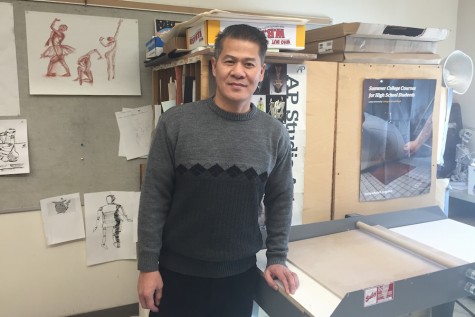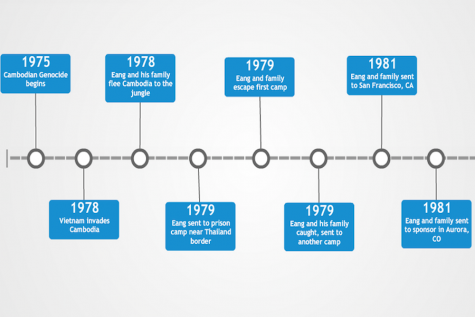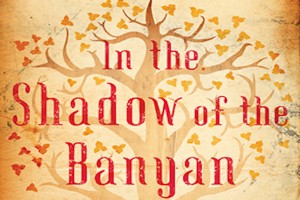Eang’s journey from Cambodia to WA
January 22, 2016
Most students at WA know of multimedia teacher Brandon Eang as an encouraging teacher who is always helping his  students learn new techniques to improve their multimedia skills. As a volleyball coach, he remains patient with his players and rarely resorts to yelling to improve their play. When first meeting him, many may notice his peaceful, calm demeanor as he patiently works with his students and players.
students learn new techniques to improve their multimedia skills. As a volleyball coach, he remains patient with his players and rarely resorts to yelling to improve their play. When first meeting him, many may notice his peaceful, calm demeanor as he patiently works with his students and players.
However, what some may not know about Eang is that he survived the Cambodian Genocide and experienced many difficult times on his journey from Cambodia to the United States.
From 1975 to 1978, Cambodia was under the control of the Khmer Rouge led by Pol Pot. This communist group installed a system that essentially brought the country back to the period where everyone worked hard labor and focused on agriculture.
Until this time in Cambodia, the first societal class mainly consisted of city dwellers including doctors, lawyers, senators, teachers and other educated citizens. The second societal class was people who worked in the fields for many generations.
However under the Khmer Rouge, the first class became the second class and the second class became the first class. So, people who used to be peasants became city dwellers and those who were previously well educated upper class were forced to work in the fields.
“Under the Khmer Rouge control, they enslaved the first class citizens, so they made the first class people slaves of their own paradise,” said Eang.
Because of the role reversal, the peasants had a lot of built up animosity towards the city dwellers, so they looked to see revenge indiscriminately. The regime allowed for this animosity to continue and civil war broke out among Cambodians.
During a three year span from 1975 to 1978, about 2.7 million Cambodians died due to starvation, disease and execution.

It was not until 1978 when Cambodia was invaded by Vietnam that Eang and his family were able to escape from Cambodia. Eang and his family lived in the jungle for about six months before eventually making their way to a refugee camp on the border of Thailand in 1979.
Eang was separated from most of his family when they reached the refugee camps. His father, brother and two older sisters were taken to different camp sites while he was sent with his mother and two younger siblings to a prison camp on the Thai border.
After spending about six months in this prison camp, Eang, his mother and two siblings attempted to escape, but were caught and sent to another camp where they remained for about two years.
“[In the camps] there was a lot of hardship and hard labor. We worked about 16 to 20 hours a day,” said Eang.
Accoring to Eang, on a good day, the refugees were woken up at 5 a.m. to walk two miles to the work site where he worked about 16 hours. After working, they would then return to the camp at around midnight and receive their one meal per day. They would get to sleep at about 1 or 1:30 a.m. and sleep for four to five hours before waking up the next morning to work the whole day once again.
“My task was to work in an assembly line to pass a mud basket from the boy in the front of me to the next…the adults were digging canals used to store rainwater and irrigate the rice, so that was my job day in and day out,” said Eang.
After being in the refugee camp for about two years, Eang and his family were sponsored by his mother’s distant relative, whom she referred to as an uncle.
This relative had been fighting with the US against the Vietcong, who had invaded Cambodia in 1978 when he was given the right to come to the US, settling in Aurora, Colorado.
“My mother’s uncle and the Catholic church co-sponsored a lot of families living the refugee camps and they just happened to sponsor our family first,” said Eang.
After passing all physical and mental tests and processing necessary paperwork, Eang, along with his mother and two younger siblings, was able to travel to San Francisco, California in 1981 where they spent the next three months living in an apartment complex that stored many refugees coming to the US. Once they had passed another series of tests to ensure they were in good health, Eang and his family flew to their final destination in Colorado to meet their sponsor, his mother’s uncle.
Eang’s interest in teaching began at a young age as his father was a teacher and he wanted to make him proud.
“I wanted to make [my father] proud and uphold the family name,” said Eang. “In the asian culture, surname…and carrying the reputation of the family is very important. He always encouraged me to go into education, so I decided to follow his advice.”
Throughout his career, Eang has taught all levels of education including elementary school, middle school, high school, and college students at Middlesex Community College.
He began teaching at Chelmsford High School in 1995 and continued teaching there until a position opened up in Westford in 2000. Eang had met the former department head at WA during a critiquing session in previous years and when a position opened up to teach graphic design, image editing and movie making, she recommended that Eang apply for the job.

Eang began teaching at WA in the fall of 2000 and has enjoyed teaching here for the past 16 years.
“I enjoy teaching high school students because I get to see them every day, interact with them every day and get to know them. So, there is a reciprocal respect,” said Eang. “You help to cultivate this individual and if the individual becomes successful later in life it makes you proud because that one moment you shared with that student, it has a very long lasting impression. That is the beauty of teaching.”
Senior Nate Feehrer took three years of multimedia classes with Eang including Intro to Movie Making and Movie Making II Honors. He enjoyed how Eang allowed students to be creative while also learning new techniques.
“Mr. Eang was one of my favorite teachers. He was fun guy, and was always really flexible with the projects he gave us,” said Feeher. “He encouraged us to be as creative as possible. He also pushed everyone in the class to enter the local film festival with the projects we made in class. This helped make the whole experience that much more exciting and worthwhile.”
Eang has always enjoyed the sport of volleyball and began playing on an intramural volleyball team in college. In 2002, the head coach of the WA boys’ varsity volleyball team thought he would be a great coach and asked him if he wanted to help coach. During his first year as head coach, Eang helped bring the team to the final tournament for the first time in WA history. Eang now coaches the varsity girls’ volleyball team in the fall and the JV boys’ team in the spring.
Senior Catherine Grondine has played on varsity volleyball for the past two years and has enjoyed having Eang as a coach and his coaching style.
“He really believes in low pressure and your motivation should come from you wanting to play your best. I think as a player for him, I wanted to be better and play well for him because I respect him so much,” said Grondine.
Bill McGuirk • Mar 22, 2018 at 8:06 pm
An outstanding article on Brandon’s journey! We were so fortunate to have him join our staff at WA where he has made such a tremendous impact on so many of us. He is the consummate educator with an empathy for his students that is unparalleled.. He is a an integral contributor to the great culture at WA. I wish him continued success.